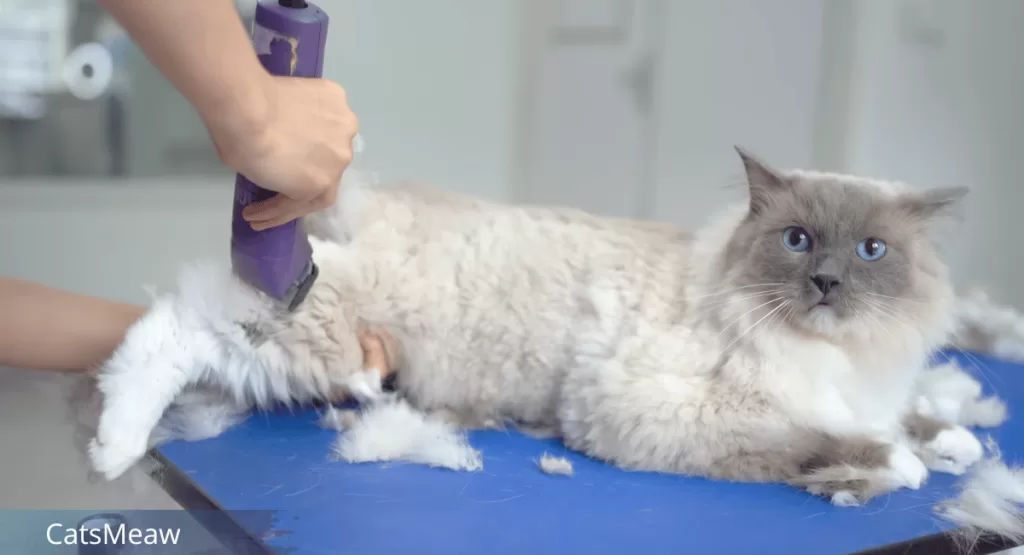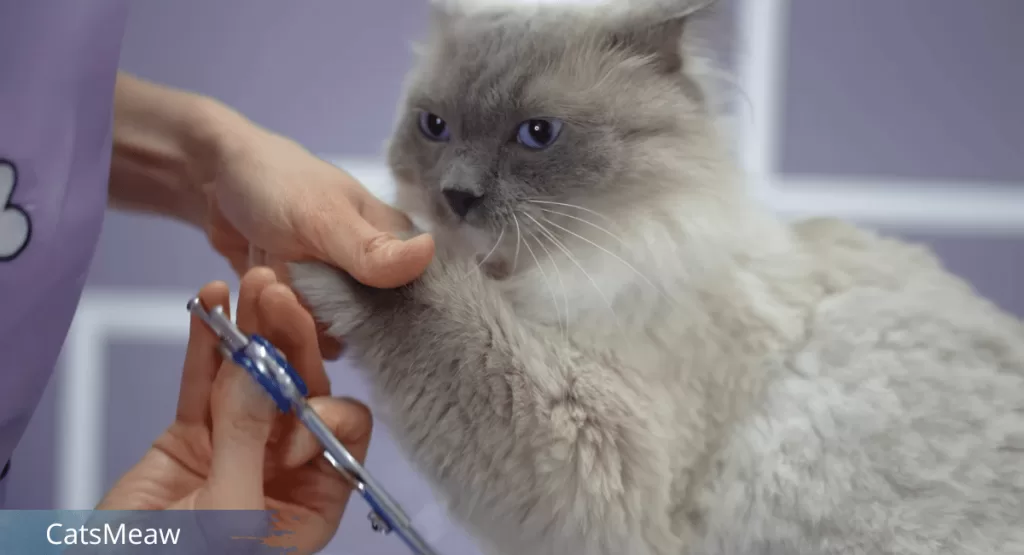We all know that Cats are known for their self-grooming habits cleanliness . However, there are times when you may need to help your cat with its grooming routine. Regular grooming not only keeps your cat’s coat healthy and shiny but also helps to prevent matting and the formation of hairballs.
Shaving a cat is sometimes necessary, especially in the case of long-haired breeds or cats with excessive shedding. By knowing how to shave a cat properly, you can ensure a safe and stress-free grooming experience for both you and your feline friend.

Table of Contents
When and why you may need to shave your cat
There are several situations where shaving a cat becomes necessary. One common reason is when your cat’s coat becomes matted or tangled, making it difficult for them to groom themselves. Matting almost lead to skin irritation, skin infections, and even discomfort. Shaving the cat’s coat helps to remove the mats and tangles, allowing the skin to breathe and preventing any potential health issues.
Another reason to shave a cat is if they have excessive shedding. Some cats shed excessively, leaving fur all over your furniture and clothes. Shaving can help to minimize shedding and make it easier to manage your cat’s fur. Additionally, if your cat has fleas or ticks, shaving their coat can make it easier to spot and remove these parasites.
Preparing for the cat shaving process
Before you start shaving your cat, it’s essential to gather not only all the necessary tools and equipment but also know how to shave a cat. This includes a cat-specific electric clipper or a pair of grooming scissors, a grooming table or a non-slip mat, grooming gloves, a comb, and treats to reward your cat’s cooperation. It’s important to choose clippers or scissors specifically designed for cats to ensure their safety and prevent accidental injuries.
Next, find a quiet and comfortable space where you can groom your cat without distractions. Make sure the room is warm enough to keep your cat comfortable during the grooming process. It’s also a good idea to lay out a towel or a blanket to catch any loose fur and make cleaning up easier afterward.
Tools and equipment needed for shaving a cat
To properly shave a cat, you will need the following tools and equipment:
- Cat-specific electric clipper or grooming scissors: These should be designed for cats to ensure their safety during the shaving process.
- Grooming table or non-slip mat: This provides a secure surface for your cat to stand on during the grooming session.
- Grooming gloves: These gloves help you to handle your cat gently and provide a sense of security for your feline friend.
- Comb: Use a comb to remove any tangles or mats before you begin shaving.
- Treats: Reward your cat with treats throughout the grooming process to keep them calm and cooperative.
Having these tools ready will help make the cat shaving process go smoothly and efficiently.
Step-by-step guide on how to shave a cat safely
Shaving a cat requires patience, caution, and a gentle approach. Follow this step-by-step guide to ensure a safe and stress-free shaving experience for your cat:
- Prepare your cat: Before you start shaving, spend some time calming and reassuring your cat. Pet and talk to them softly to help them relax. If your cat is extremely anxious or aggressive, consider seeking professional help or consulting your veterinarian.
- Remove tangles and mats: Use a comb to gently remove any tangles or mats in your cat’s fur. Be aware not to tug on or pull the fur, as this may cause pain or discomfort.
- Introduce the clippers: Turn on the clippers and let your cat become familiar with the sound and vibrations. Gradually approach your cat with the clippers, allowing them to sniff and investigate.
- Start shaving: Begin shaving your cat’s fur in the direction of hair growth, using slow and gentle strokes. Take breaks if your cat becomes stressed or agitated. Remember to be extra careful around sensitive areas such as the face, ears, and tail.
- Monitor your cat’s comfort: Throughout the shaving process, pay attention to your cat’s body language and behavior. If the cats show signs of discomfort, pain or distress, stop immediately and give them a break. You can resume shaving once your cat has calmed down.
- Finish the shave: Once you have completed shaving your cat’s body, carefully trim the fur around the face, ears, and paws using grooming scissors. Be cautious and take your time to avoid any accidental injuries.
- Reward your cat: After the shave, reward your cat with treats and praise for their cooperation. This positive reinforcement will certainly aid your cat associate grooming with positive experiences.
Tips for handling an aggressive cat during the shaving process
Shaving a cat can be challenging, especially if your cat is anxious or aggressive. Here are some tips to help you handle an anxious or aggressive cat during the shaving process:
- Use calming techniques: Before starting the shave, try using calming techniques such as playing soft music or using pheromone sprays designed for cats. These can help create a relaxing environment for your cat.
- Seek professional help: If you are struggling to handle your cat’s aggression or anxiety. consider seeking professional help and you may ask for practicle session about how to shave a cat. A professional groomer or a veterinarian experienced in cat grooming can provide guidance and assistance.
- Utilize grooming gloves: Grooming gloves can help you handle an anxious or aggressive cat more safely. The gloves provide a sense of security and prevent accidental scratches or bites.
- Take breaks: If your cat becomes stressed or agitated, take breaks during the shaving process. Allow your cat to calm down before continuing. Patience is key when dealing with a cat that is anxious or aggressive.
- Consider sedation: In extreme cases, your veterinarian may recommend sedating your cat for the grooming process. Sedation should only be done under the guidance of a professional to ensure your cat’s safety.
Related: Best Guide to Trimming Your Cat’s Nails
Remember, the well being and safety of your furry friend should always be the first priority. If you are unsure or uncomfortable with shaving your cat yourself, consult a professional groomer or veterinarian.

Post-shave care and maintenance for your cat
After shaving your cat, it’s important to provide post-shave care to ensure their comfort and well-being. Here are some post-shave care tips:
- Keep your cat warm: Shaving removes a layer of insulation, so make sure your cat has access to warm and cozy areas in your home. Provide your cat with heated pads or blankets to help it regulate their body temperature.
- Monitor for any skin issues: Keep an eye on your cat’s skin for any signs of irritation, redness, or rashes. If you see any abnormalities, do not hesitate consult your veterinarian for further guidance.
- Regular brushing: Even with a shaved coat, your cat will still benefit from regular brushing. Brushing helps to remove loose fur, stimulate the skin, and maintain a healthy coat. Use a soft brush or grooming glove to gently brush your cat’s fur.
- Gradually reintroduce outdoor activities: If your cat is used to spending time outdoors, it’s important to gradually reintroduce outdoor activities after shaving. Start with short supervised sessions and gradually increase the duration to allow their skin to adjust to the change in temperature.
- Schedule regular grooming sessions: Regular grooming sessions, including brushing and nail trimming, should be a part of your cat’s routine. This helps to prevent matting, keeps their coat healthy, and strengthens the bond between you and your cat.
The benefits of regular cat grooming
Regular grooming is essential for the overall health and well-being of your cat. It helps to prevent matting, reduce shedding, and minimize the risk of skin infections. knowing how to shave a cat may be necessary in certain situations, such as excessive matting or shedding. By following the proper techniques and using the right tools, you can ensure a safe and stress-free grooming experience for both you and your cat.
Remember to always prioritize your cat’s comfort and well-being during the shaving process. If your cat is anxious or aggressive, seek professional help or consult your veterinarian. Alternative grooming options, such as professional grooming services or lion cuts, can be considered for cats who don’t tolerate shaving.
Ultimately, regular grooming and a positive grooming experience strengthen the bond between you and your cat while keeping them healthy and happy. So, take the time to groom your cat regularly and provide them with the care they deserve.
